This is easily my favorite article of the year. We cover a lot of material each year on Metagame, but the subject of what makes a card good is something that I don’t think we’ve ever talked about. As I mention in the article, being able to identify potential powerhouses by decomposing the elements of the card is something that most players cannot or will not do. A wise player will make the effort to learn why the good cards are good and use this to his or her advantage to turn profits and gain a competitive advantage over others. If that sounds good to you, then this is an article that you won’t want to miss. Even if you’ve already read it, it’s interesting to see it again now that Detroit is over. I’m definitely ready to place Mark of the Rose and Tytannial, Princess of Camellias firmly in the "good" column now.
-Jerome
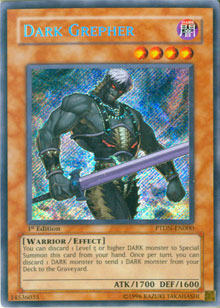 What makes a card good? This question has been debated since the origins of trading card games, but the qualities that make a card good remain constant throughout. It makes me sad when people only look at one aspect of a card to the exclusion of all else, because it frequently leads them to the completely wrong conclusion! Remember Dark Grepher? It got to eat a lot of hate until people started using it to set up first- and second-turn multiple Dark Armed Dragon drops, and it still sees play today in Teleport Dark Armed Dragon decks.
What makes a card good? This question has been debated since the origins of trading card games, but the qualities that make a card good remain constant throughout. It makes me sad when people only look at one aspect of a card to the exclusion of all else, because it frequently leads them to the completely wrong conclusion! Remember Dark Grepher? It got to eat a lot of hate until people started using it to set up first- and second-turn multiple Dark Armed Dragon drops, and it still sees play today in Teleport Dark Armed Dragon decks.
Being able to identify the good cards in a new set is a valuable skill for a number of reasons. First, being able to recognize all the cards with competitive potential keeps you ahead of the curve in terms of predicting and exploiting metagame trends. Keeping with the example above, the people who recognized the potential of Dark Grepher from the start won a lot more games than the players who were shunning it. Soon after, everyone was using Grepher. The early adopters gained a competitive advantage by correctly assessing the potential of the card.
The second advantage gained by those who can accurately assess the quality of a card is a financial one. If you see a new card at the sneak preview that you’re absolutely certain is good but everyone else is willing to give up easily, then—if and when that card takes off in popularity—you already have at least a playset of it. From there, you can enjoy a huge return on your investment by trading your extra copies of the card away for whatever else you might need. A good recent example of this is Thought Ruler Archfiend. At first, everyone was crazy for Stardust Dragon and Goyo Guardian because they were blatantly good. Thought Ruler managed to coast under the radar, at least at the sneak preview, and as a result, I was able to get a lot of them for next to nothing. A few weeks later, people started figuring out that everyone was going to main-deck things like Phoenix Wing Wind Blast to help deal with Stardust Dragon, and suddenly, Thought Ruler Archfiend was in vogue. Next thing I knew, people started trading me copies of Goyo Guardian and Emergency Teleport straight up for my spare Thought Rulers. Another good example is Goblin Zombie. For a while, Goblin Zombie was easy to come by—averaging about twenty dollars on the secondary market—but now that Plaguespreader Zombie is in the mix, that number is going up and isn’t likely to stop.
Finally, there’s something to be said for being able to interact knowledgably with other players who know what they’re doing. Players prefer to interact with other players of an equal or higher skill level. This ensures that they’re continually improving themselves by facing and attempting to overcome greater challenges. One way to distinguish yourself from the crowd is to know what you’re talking about. Walking around talking about how the next big thing is trash simply because you failed to see its worth is a surefire way to be ignored or dismissed by more knowledgeable players. Also, remember that it’s better to be open-minded about new cards than closed-minded, as it minimizes your chances to get burned (both strategically and financially).
Now that you know why it’s important to accurately evaluate cards, let’s talk about the many factors that can cause cards to stand out above the rest and explore how various combinations of these factors have propelled certain cards to eternal popularity.
Accelerates
A card that accelerates will give you more of whatever it is you need to execute your strategy. The three most common ways to accelerate strategies are by searching out key cards, drawing more cards, or granting/performing extra summons. Nearly all the good cards that accelerate strategies are spells of some sort, though there are some noteworthy monsters and traps that fall into this category. Spells can be played as soon as they’re drawn, and there’s no limit to how many you can play in a turn. This makes them the ideal type of card to accelerate your game plan. Note that these types of cards don’t necessarily have to improve your overall card presence to be accelerators. In fact, some of them (like Double Summon) flat-out detract from this. When you’re evaluating such an accelerator for potential use, make sure that whatever advantage you’re going to gain isn’t completely offset by any drawbacks. For example, Upstart Goblin gets you one card deeper into the deck, but it also gives your opponent 1000 life points, and that’s all it does. Basically, it lets you play a 37-card deck if you run three of them. In nearly all circumstances, this is pointless. The main exceptions are when you absolutely need to get to a certain card in order to win, such as in a combo deck. Quick-play status, while always appreciated, generally isn’t needed with a card that’s going to accelerate your game plan unless that particular card has an application during the battle phase. For maximum speed, look for cards that accelerate in more than one way.
Removes
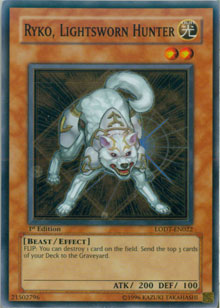 After cards that let you draw, removal is by far the most popular effect in the game. After all, the only good opposing threat is the one you just blasted into oblivion! The word "removal" encompasses anything that takes cards off the field, but some types of removal are more permanent than others. Removal cards are generally rated based on what they remove, how easily they do so, and whether or not they have a cost to be activated. In general, free destruction is preferred over cards with a cost, so players will go to Smashing Ground before they’ll consider Lightning Vortex. When considering removal, always keep in mind what you’re going to be using it for. Lightning Vortex is a lot better than Smashing Ground when it comes to taking out a pair of Gladiator Beast Laquari cards, and Phoenix Wing Wind Blast is a lot better than both if you need to get rid of Stardust Dragon. Judging removal is tricky, since card quality in this category is directly related to what relevant threats the card can dispose of. As this is constantly in flux, the list of which removal cards are "good" or not changes. In general, you want to pick up any sort of generic removal card especially if it has high utility like Ryko, Lightsworn Hunter.
After cards that let you draw, removal is by far the most popular effect in the game. After all, the only good opposing threat is the one you just blasted into oblivion! The word "removal" encompasses anything that takes cards off the field, but some types of removal are more permanent than others. Removal cards are generally rated based on what they remove, how easily they do so, and whether or not they have a cost to be activated. In general, free destruction is preferred over cards with a cost, so players will go to Smashing Ground before they’ll consider Lightning Vortex. When considering removal, always keep in mind what you’re going to be using it for. Lightning Vortex is a lot better than Smashing Ground when it comes to taking out a pair of Gladiator Beast Laquari cards, and Phoenix Wing Wind Blast is a lot better than both if you need to get rid of Stardust Dragon. Judging removal is tricky, since card quality in this category is directly related to what relevant threats the card can dispose of. As this is constantly in flux, the list of which removal cards are "good" or not changes. In general, you want to pick up any sort of generic removal card especially if it has high utility like Ryko, Lightsworn Hunter.
Combolicious
A card that is strictly combolicious seems lame, weak, or underpowered on its own, but once you start bringing other cards into the mix for it to play off of, it becomes ridiculous. I think the classic examples of strictly combolicious cards are Convulsion of Nature and Archfiend’s Oath. Alone, they make you snicker and say, "that’s cute." Together, they form a major portion of the card-drawing engine that propelled Vincent Tundo’s Life Equalizer deck to fame in 2006. In fact, that entire deck is filled with combolicious cards that just happen to become ridiculous when they’re played with each other. Most players tend to ignore this type of card unless it can be used in a blatantly obvious OTK strategy, but a well-rounded player will see these cards, recognize what they’re capable of, and squirrel a few copies away just in case someone figures out how to take that cute combo deck and turn it into a metagame-mauling monster. A current example of the sort of thing I’m talking about is the Imperial Iron Wall/Quillbolt Hedgehog combo deck. It’s not very good right now, but you might want to grab as many copies of Imperial Iron Wall as you can: it’s got about a million applications, and this deck is one of them. (Jason’s Note—coincidentally, I just picked up 30 copies of this card for next to nothing last week.)
Wins the Game
 I like to think that this one is fairly self-explanatory. A card that wins the game is exactly what it sounds like: a win condition. It’s usually not very difficult to tell that a card is a game-winner, although in the case of spell and trap cards of this sort, it’s usually hidden behind one or more of its other qualities. "Wins the game" almost never comes alone. It’s usually backed by some combination of accelerates, removes, combolicious, disruption, and Forbidden-level power. Monsters that win the game are surprisingly frequent as of late with Dark Armed Dragon, Judgment Dragon, Gladiator Beast Gyzarus, and some Synchro monsters all being released in a continuous block of four sets. Be careful, however. There are many cards that look like they should win the game, but definitely don’t. Vennominaga the Deity of Poisonous Snakes is the biggest offender here: while the card flat-out has a win condition built into it, it’s nearly impossible to play, making its "win the game" effect worthless. When evaluating a potential "win the game" card, make sure that you consider what you need to do in order to play it before you trade for it.
I like to think that this one is fairly self-explanatory. A card that wins the game is exactly what it sounds like: a win condition. It’s usually not very difficult to tell that a card is a game-winner, although in the case of spell and trap cards of this sort, it’s usually hidden behind one or more of its other qualities. "Wins the game" almost never comes alone. It’s usually backed by some combination of accelerates, removes, combolicious, disruption, and Forbidden-level power. Monsters that win the game are surprisingly frequent as of late with Dark Armed Dragon, Judgment Dragon, Gladiator Beast Gyzarus, and some Synchro monsters all being released in a continuous block of four sets. Be careful, however. There are many cards that look like they should win the game, but definitely don’t. Vennominaga the Deity of Poisonous Snakes is the biggest offender here: while the card flat-out has a win condition built into it, it’s nearly impossible to play, making its "win the game" effect worthless. When evaluating a potential "win the game" card, make sure that you consider what you need to do in order to play it before you trade for it.
Utility
A high-utility card does a lot of different things, but not as well as any single effect would be executed by a card dedicated to it. The classic example is Enemy Controller. It can block an attack like Book of Moon, but completely loses out on Book of Moon’s combolicious and disruption potential. It can also steal a monster like Change of Heart or Brain Control, but unlike those two, you have to tribute a monster to do so. To make up for it, you get both effects at quick-play speed making Enemy Controller useful at many different times throughout the game. A good example of a recent high-utility card is Psychokinesis. It can destroy any card on the field—something that very few removal cards can do—but you need to control a Psychic-type monster and you’ll take 1000 damage when you’re finished. It destroys anything, and it’s a normal spell (unlike Raigeki Break). It’s also an even trade with your opponent. The big drawback is that you can’t splash it into any deck. Utility doesn’t necessarily mean that it can go into every deck ever, and it’s important to recognize this when you’re evaluating a new card for utility. As with "win the game" cards, ease of use is of great importance when deciding whether or not to invest. Personally, I think Psychokinesis is quite good. Psychic decks got a number of new toys to play with in Crossroads of Chaos, including Psychokinesis, and I believe it’s only a matter of time until either a winning build is created or a blatant "win the game" card for them is released.
Forbidden-Level Power
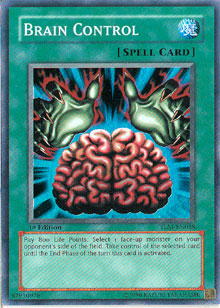 Forbidden-level power is one of my favorite qualities to see in a new card, especially because it makes me feel like the card it imitates will never return to the Advanced format. Quite simply, a card with Forbidden-level power replicates the effect of a Forbidden card. An excellent dual-example of this is Sky Scourge Enrise and Sky Scourge Norleras. They’re clearly intended to be "fixed" versions of Chaos Emperor Dragon - Envoy of the End and either Chaos Sorcerer or Black Luster Soldier - Envoy of the Beginning. Unfortunately, neither one is very good. It’s easy to see Forbidden-level power when it shows up, but it’s not often that the card in question is useful. Part of the reason why cards are Forbidden is because they’re ridiculously powerful and too easy to use. You can see that in the restrictions that were put on the faux-Chaos monsters to make them fair. You should generally avoid this sort of card unless it’s visibly playable (like Brain Control) or has combolicious potential, since these kinds of cards are frequently impossible to use effectively.
Forbidden-level power is one of my favorite qualities to see in a new card, especially because it makes me feel like the card it imitates will never return to the Advanced format. Quite simply, a card with Forbidden-level power replicates the effect of a Forbidden card. An excellent dual-example of this is Sky Scourge Enrise and Sky Scourge Norleras. They’re clearly intended to be "fixed" versions of Chaos Emperor Dragon - Envoy of the End and either Chaos Sorcerer or Black Luster Soldier - Envoy of the Beginning. Unfortunately, neither one is very good. It’s easy to see Forbidden-level power when it shows up, but it’s not often that the card in question is useful. Part of the reason why cards are Forbidden is because they’re ridiculously powerful and too easy to use. You can see that in the restrictions that were put on the faux-Chaos monsters to make them fair. You should generally avoid this sort of card unless it’s visibly playable (like Brain Control) or has combolicious potential, since these kinds of cards are frequently impossible to use effectively.
Protection
Cards with a protection effect are highly valued since removal is highly valued. A card with a protection effect saves either itself or other cards from being destroyed or otherwise disrupted by opposing actions. Thought Ruler Archfiend can negate targeted spells and traps. Stardust Dragon can negate anything that would destroy a card on the field. These are protection effects, and part of the reason they’re so valuable is that they’re on huge, easy-to-summon monsters. Mirage Dragon has a protection effect, but its size isn’t big enough for it to be important. When you see a protection effect, you need to ask yourself if you can get the card to the field and make it stick. Furthermore, if you do manage to get it out, is it worth it? Field Barrier is an example of a protection card that is clearly not worth it. Marshmallon is an example of one that is. The jury is still out on Tytannial, Princess of Camellias, but I’m leaning toward saying that she is worth it owing to the ease with which she and the fodder needed to fuel her effect are summoned.
Recursion
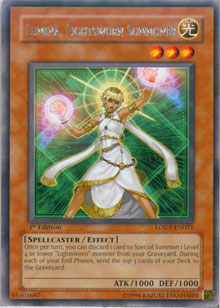 Recursive effects let you re-use cards that you’ve already spent or destroyed. The most common type of recursion effect special summons one or more monsters from the graveyard, so it frequently also serves to accelerate your game plan. Monster Reborn is the quintessential recursion card, but Dark Magician of Chaos is often considered to be the most powerful because of all the combos that he sets up. The usefulness of a recursion card is defined by what it can bring back and the speed at which it can do so. As such, spells make for the best recursion cards, though traps add an extra element of strategy that can often be turned into an advantage despite the fact that you can’t play them the turn you draw them. Recursion abilities on monster cards aren’t printed very often, but when they are they’re almost always excellent. Lumina, Lightsworn Summoner is an example of a monster with a recursion effect that’s still allowed in Advanced play. Magician of Faith and Dark Magician of Chaos are reminders of the incredible power that this type of effect can wield. When evaluating recursion effects, you need to keep an eye on the cost involved, if any, and compare it to the range of cards you can bring back. If the cards that you can bring back with the effect aren’t worth what you have to give up doing so, then the card probably isn’t very good outside of a combo deck that needs to be able to retrieve its win condition. Magical Stone Excavation is a good example of a card that never sees play outside of decks that can either play it for free with a different effect, need it to recover a win condition, or both.
Recursive effects let you re-use cards that you’ve already spent or destroyed. The most common type of recursion effect special summons one or more monsters from the graveyard, so it frequently also serves to accelerate your game plan. Monster Reborn is the quintessential recursion card, but Dark Magician of Chaos is often considered to be the most powerful because of all the combos that he sets up. The usefulness of a recursion card is defined by what it can bring back and the speed at which it can do so. As such, spells make for the best recursion cards, though traps add an extra element of strategy that can often be turned into an advantage despite the fact that you can’t play them the turn you draw them. Recursion abilities on monster cards aren’t printed very often, but when they are they’re almost always excellent. Lumina, Lightsworn Summoner is an example of a monster with a recursion effect that’s still allowed in Advanced play. Magician of Faith and Dark Magician of Chaos are reminders of the incredible power that this type of effect can wield. When evaluating recursion effects, you need to keep an eye on the cost involved, if any, and compare it to the range of cards you can bring back. If the cards that you can bring back with the effect aren’t worth what you have to give up doing so, then the card probably isn’t very good outside of a combo deck that needs to be able to retrieve its win condition. Magical Stone Excavation is a good example of a card that never sees play outside of decks that can either play it for free with a different effect, need it to recover a win condition, or both.
Disruption
Disruption effects exist specifically to mess with your opponent. Every counter trap is a disruption effect of some sort, as are all the cards that discard cards from your opponent’s hand. Negation abilities also sometimes fall into this category, but most fall under the category of protection. The classic disruption card is Delinquent Duo, allowing you to steal away two cards from the opponent’s hand for 1000 life points. It’s unsurprisingly Forbidden, but it goes to show how powerful disruption effects can be. The best disruption effects available to us are tacked onto cards that have other qualities listed above. Phoenix Wing Wind Blast is a prime example of this, as it disrupts the opponent by removing a card he or she controls from the field and forcing the opponent to either redraw it or lose it forever . . . along with everything he or she invested in it.
Now that you know the qualities you’re looking for when evaluating a card, let’s take a look at some of the cards that are popular today, some sleeper hits, and some places where everything is there but something went horribly wrong.
Winning Combinations!
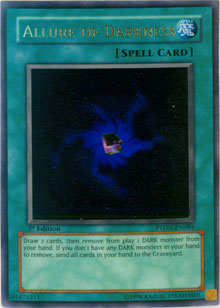 Accelerates + Combolicious = Allure of Darkness
Accelerates + Combolicious = Allure of Darkness
Allure of Darkness was a winner from the get-go, allowing Dark Armed Dragon Return to draw through to its copies of Dark Armed Dragon and Dimension Fusion while simultaneously loading up the removed from play zone with everything it needed to win. It’s simple, easy, and works with a lot of the best monsters in the game.
Removal + Disruption + Combolicious = Phoenix Wing Wind Blast
A staple of the current Teleport Dark Armed Dragon decks, Phoenix Wing Wind Blast removes a threat, disrupts the opponent’s tempo, and allows you an outlet to discard combo cards like Destiny Hero - Malicious. Its only drawback is that it’s a trap, which can still come in handy by absorbing an opposing removal card!
Accelerates + Removal + Utility = Gladiator Beast Gyzarus
When a Gladiator Beast deck makes a Gyzarus play, it almost always winds up special summoning at least three monsters that turn: first, the Gyzarus itself, which removes two cards and potentially destroys another monster while dealing damage. Then it brings any two non-Bestiari Gladiator Beasts from your deck, letting you claim whatever effects you might need to finish clearing the opposing field or otherwise keep the game out of reach for your opponent! Gyzarus is nasty incarnate.
Protection + Disruption = Spirit Reaper
Spirit Reaper wasn’t Limited for the longest time. Then people started playing three of them in every deck, and it quickly became apparent how potent its "you can’t kill me and woe be to you if you don’t have a monster" effects were. Reaper is sure to drag any game into the mud if it sticks around for more than a turn or two, and half the time it’ll do so immediately after stealing away your opponent’s key card.
Hidden Gems
Removal + Utility + Combolicious = Ryko, Lightsworn Hunter
Does it blow something up? Check. Can it blow anything up? Check! Does it also interact favorably with a ton of other cards? Absolutely. Ryko is the full package, and the only thing that drags it down is the fact that it’s a flip-effect monster. It should always see play in the Lightsworn deck, but the tricky business is figuring out all the other decks it’s good in. There are a lot of them. You should always keep at least a playset of this card, because it’s not going to stop being good until people stop playing cards.
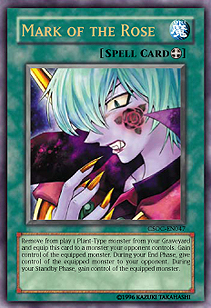 Accelerates + Removal + Forbidden-Level Power + Wins the Game = Mark of the Rose
Accelerates + Removal + Forbidden-Level Power + Wins the Game = Mark of the Rose
I know I’m trading like mad to get as many of these as I can, and it’s because it really is all four of those things listed above. It gets you the opponent’s monster, thereby getting rid of his or her monster by replicating Snatch Steal to keep the way cleared for your game-ending strike. It may seem like it only goes in Plant decks, but keep in mind that Emergency Teleport, at a glance, only goes in Psychic decks.
Accelerates + Combolicious + Wins the Game = Overdrive Teleporter
This card was taking a lot of undue heat at the sneak preview since there aren’t very many level-3 Psychic-type monsters yet. All those people will be really sad when we do get more and they happen to be excellent. Overdrive Teleporter is just waiting to explode onto the scene, and I wouldn’t really be surprised if it does so even with Psychic Commander as the best thing it can summon.
Failed Experiments
Protection + Recursion + Wins the Game = Don’t play Vennominaga the Deity of Poisonous Snakes
A card with three fantastic abilities is rendered thoroughly unplayable by its method of summon. Avoid this one at all costs.
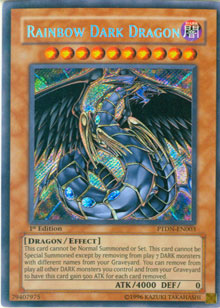 Accelerates + Combolicious + Wins the Game = Don’t play Rainbow Dark Dragon
Accelerates + Combolicious + Wins the Game = Don’t play Rainbow Dark Dragon
It’s a special summon, it loads your removed from play zone with everything you could possibly want to bring back, and it can pump itself to game-winning proportions. None of that makes it good. Rainbow Dark Dragon has failed even in a combo deck specifically designed to make it work, and that’s a sure-fire sign that you should pass on it.
Protection + Utility = Don’t play Gladiator Beast Alexander
It may be immune to spells and capable of tagging out to any other Gladiator Beast you need . . . but why would you ever tag it out? Especially after you had to use an impractical card like Gladiator Beast Dimacari to bring it out? There’s really no reason to play this card, especially when the nastiest removal is trap-based anyway.
Hopefully you’ve come away with a greater appreciation of why it’s important to be able to evaluate cards and a better idea of the things you should be looking for. It’s a lot of information, but it’s all here for you to read or re-read at your leisure. Try to avoid trashing good cards, and until next time, play hard, play fair, and most importantly, have fun!
—Jerome McHale
Jerome.mchale@gmail.com